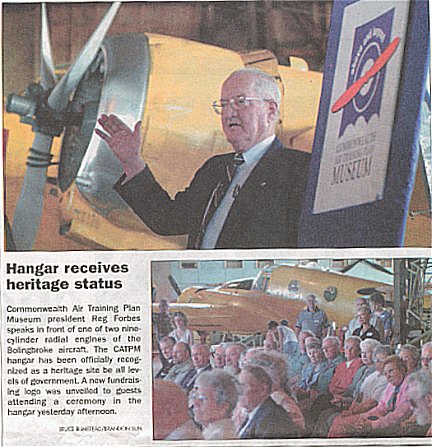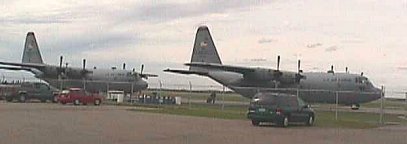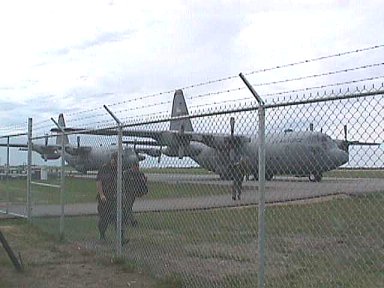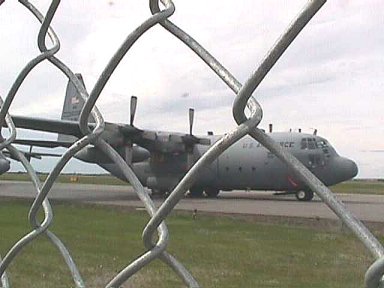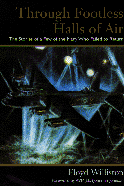Skies above Brandon will be abuzz today as military
personnel touch down in the city.
Nine C-130 Hercules aircraft will begin arriving around
noon, carrying members of the Missouri National Guard on their way to Canadian
Forces Base Shilo for training exercises. Canadian troops aboard many Bell-412
helicopters will also be landing, making for one of the busiest days the
Brandon airport has seen.
"There's going to be a whole bunch of metal flying around
here. . . It'll be lots of fun," says Corey Allum of the Brandon Flying
Club. All the activity means between 50,000 and 60,000 litres of fuel will
be sold, Allum says, or about $50,000 worth.
Missouri National Guard members are arriving on the heels
of their counterparts from Wyoming, who have been training at Shilo all
week. About 300 members of an artillery regiment of the Wyoming National
Guard will wrap up exercises early next week. The 800-strong Missouri artillery
group will be in the field for about a week. Some of its members have arrived,
along with their equipment, which was transported by train.
A third U.S. National Guard troop will round out the visits
later this month.
"Just as Missouri's coming out of the field, North Dakota's
arriving, so they all kind of overlap by a few days each, so right till
the end of the month, we have Wyoming, then Missouri, then North Dakota,"
says Lori Truscott, public affairs officer with CFB Shilo. The group from
North Dakota is an engineers' battalion of about 400.
Truscott says it's also a busy summer for Canadian activity,
with regular summer training rotation with the Western Area Training Centre
and a new group of communications reserves. A permanent summer reserve
training program at Shilo is in the process of being set up with the communications
reserves, she says. "From what I understand, the people coming in to train
with them are going to be as-raw-as-you-get recruits, doing basic military
training," Truscott says.
This book chronicles the lives of six airmen
from Atlantic Canada based in Britain who died during the war against Nazi
Germany. Well illustrated, it provides a glimpse of war from a different
perspective.
War is a sorry business. It is the opposite of civilized
behaviour. It is an experience that no soldier, sailor, or airmen, who,
having once been there, would wish on anyone. This is certainly the opinion
of author Floyd Williston as he recreates for us the last days on earth
of six brave men from Atlantic Canada who died tragically in one of mankind's
most gruesome wars. Books on war frequently deal with the major decisions
taken by political and military leaders. Through Footless Halls of Air
deals instead with the ordinary, insignificant men who usually die as unsung
heroes. It is a splendid book, well written and very interesting.
In order to flesh out the personalities of the men featured
in his book, Williston provides many details of their personal lives and
includes many quotations by the men and their acquaintances as they awaited
their fate. This approach does indeed show us that these men were more
than just cogs in a military machine - by showing the hopes and tears of
the six men, Williston brings out the human side of war.
The inclusion of many photos of the airmen and the aircraft
they died in also helps to make the story come alive. So too do the drawings
of some of the bombers mentioned, with their specifications, bomb capacity,
and crew size. We can easily imagine, with Williston's help, just what
these men went through as they set off again and again on hazardous, often
futile missions. War in Williston's hands becomes cruel and horrible and
the ordinary men who gave their lives so willingly become larger than life.
As we read about their moments of death, we are left wondering just what
they might have accomplished had they not been plucked away in the prime
of life.
Five of Williston's heroes (David Albert Romans, Albert
Williston, Earle K. Reid, Fred Mifflin, and James Tuplin) flew with bomber
command. The trials and tribulations they had to endure are remarkable.
Foremost among these trials was the raid on Nuremberg on March 30-31, 1944,
when everything that could go wrong did and one hundred and eleven Canadian
airmen died. This raid, according to Williston, should never have taken
place because of weather conditions. In his hands, it sounds just as futile
as the infamous "Charge of the Light Brigade" during the Crimean War.
Chapter Five is about Squadron Leader, Norman Fowlow who
flew a Spitfire. What made his final flight so remarkable was that his
plane acted as a dive-bomber carrying a five-hundred-pound bomb. As Williston
says, "such Spitfire dive-bombing sorties were almost always suicidal.
The bomb, which was strapped to the plane's belly section, was unprotected
and totally exposed to German anti-aircraft flak." This was how Fowlow
died.
In Through Footless Halls of Air we even learn details
about some of the German fighter pilots and crew who defended against the
incoming allied bombers. The one we learn the most about is Major Prinz
Wittgenstein, a German air ace who may have shot down Williston's brother,
Albert. Williston does not hate this man, as well he might, but realizes
that he too was a hero who died just as needlessly as his Canadian foes.
Through Footless Halls of Air is a story that deserves
to be told. It gives war a human face and will be enjoyed by a wide audience,
not just former service men.
Highly recommended.
Thomas F. Chambers is a professor
of politics, economics, and history at
Canadore College of Applied Arts and Technology
in North Bay, Ontario.
Copyright © 1997 the Manitoba Library Association.
Reproduction for personal use is permitted only
if this copyright notice is maintained.
Any other reproduction is prohibited without permission.
WWII
A BRITISH FOCUS

http://www.warlinks.com/
World War II Memories ~ A huge database of WWII sites
~ Discussions ~ Photos
Murphy's Laws Of Combat Operations
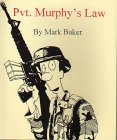
Pvt.
Murphy's Law
ISBN: 0967935709
Pub. Date: August 1, 1999
Friendly fire - isn't.
Recoilless rifles - aren't.
Suppressive fires - won't.
You are not Superman; Marines and fighter pilots take
note.
A sucking chest wound is Nature's way of telling you
to slow down.
If it's stupid but it works, it isn't stupid.
Try to look unimportant; the enemy may be low on ammo
and not want to waste a bullet on you.
If at first you don't succeed, call in an airstrike.
If you are forward of your position, your artillery will
fall short.
Never share a foxhole with anyone braver than yourself.
Never go to bed with anyone crazier than yourself.
Never forget that your weapon was made by the lowest
bidder.
If your attack is going really well, it's an ambush.
The enemy diversion you're ignoring is their main attack.
The enemy invariably attacks on two occasions: when they're
ready & when you're not.
There is no such thing as a perfect plan.
Five second fuzes always burn three seconds.
There is no such thing as an atheist in a foxhole.
A retreating enemy is probably just falling back and
regrouping.
The important things are always simple; the simple are
always hard.
The easy way is always mined.
Teamwork is essential; it gives the enemy other people
to shoot at.
Don't look conspicuous; it draws fire. For this reason,
it is not at all uncommon for aircraft carriers to be known as bomb magnets.
Never draw fire; it irritates everyone around you.
If you are short of everything but the enemy, you are
in the combat zone.
When you have secured the area, make sure the enemy knows
it too.
Incoming fire has the right of way.
No combat ready unit has ever passed inspection.
No inspection ready unit has ever passed combat.
If the enemy is within range, so are you.
The only thing more accurate than incoming enemy fire
is incoming friendly fire.
Things which must be shipped together as a set, aren't.
Things that must work together, can't be carried to the
field that way.
Radios will fail as soon as you need fire support.
Radar tends to fail at night and in bad weather, and
especially during both.
Anything you do can get you killed, including nothing.
Make it too tough for the enemy to get in, and you won't
be able to get out.
Tracers work both ways.
If you take more than your fair share of objectives,
you will get more than your fair share of objectives to take.
When both sides are convinced they're about to lose,
they're both right.
Professional soldiers are predictable; the world is full
of dangerous amateurs.
Military Intelligence is a contradiction.
Fortify your front; you'll get your rear shot up.
Weather ain't neutral.
If you can't remember, the Claymore is pointed towards
you.
Air defense motto: shoot 'em down; sort 'em out on the
ground.
'Flies high, it dies; low and slow, it'll go.
The Cavalry doesn't always come to the rescue.
Napalm is an area support weapon.
Mines are equal opportunity weapons.
B-52s are the ultimate close support weapon.
Sniper's motto: reach out and touch someone.
Killing for peace is like screwing for virginity.
The one item you need is always in short supply.
Interchangeable parts aren't.
It's not the one with your name on it; it's the one addressed
"to whom it may concern" you've got to think about.
When in doubt, empty your magazine.
The side with the simplest uniforms wins.
Combat will occur on the ground between two adjoining
maps.
If you can keep your head while those around you are
losing theirs, you may have misjudged the situation.
If two things are required to make something work, they
will never be shipped together.
Anything you do can get you shot, including nothing.
Whenever you lose contact with the enemy, look behind
you.
The most dangerous thing in the combat zone is an officer
with a map.
The quartermaster has only two sizes, too large and too
small.
If you really need an officer in a hurry, take a nap.
There is nothing more satisfying than having someone
take a shot at you, and miss.
If your sergeant can see you, so can the enemy.
You'll only remember your hand grenades when the sound
is too close to use them.
Close only counts in horseshoes and hand grenades.
Well .. It could be worse: It could be raining .. and
we could be out in it.
So he said, "Cheer up: it could be worse!" So we cheered
up. And it got worse.
The side with the simplest uniform wins...
The spare batteries for the PRC-whatever your troops
have been carrying are either nearly dead or for the wrong radio.
The ping you heard was the antenna snapping off at 6
inches above the flexmount, while a fire mission was being called in on
a battalion of hostiles who know your position.
Why is it the CO sticks his head in your radio hooch
to see if anything has come down from DIV when you are listening to the
VOA broadcasting the baseball games?
How come you are on one frequency when everyone else
is on another?
Why does your 500-watt VRC-26 (real old) not make it
across 200 miles while a ham with 50 watts on the same MARS frequency can
be heard from Stateside?
Know why short RTOs have long whips on their radios?
So someone can find them when they step in deep water.
The enemy "Alway's" times his attack, to the second you
drop your pants in the Latrine!!
The ammo you new "NOW"!! is on the "Next" airdrop!!!
The
Rules of the Air
As candidates for Undergraduate Pilot Training, you will
be required to memorize the following: Rules Of The Air
*Every takeoff is optional. Every landing is mandatory.
*If you push the stick forward, the houses get bigger.
If you pull the stick back, they get smaller. That is, unless you keep
pulling the stick all the way back, then they get bigger again.
*Flying isn't dangerous. Crashing is what's dangerous.
*It's always better to be down here wishing you were
up there than up there wishing you were down here.
*The ONLY time you have too much fuel is when you're
on fire.
*The propeller is just a big fan in front of the plane
used to keep the pilot cool. When it stops, you can actually watch the
pilot start sweating.
*When in doubt, hold on to your altitude. No one has
ever collided with the sky.
*A 'good' landing is one from which you can walk away.
A 'great' landing is one after which they can use the plane again.
*Learn from the mistakes of others. You won't live long
enough to make all of them yourself.
*You know you've landed with the wheels up if it takes
full power to taxi to the ramp.
*The probability of survival is inversely proportional
to the angle of
arrival. Large angle of arrival, small probability of
survival and vice versa.
*Never let an aircraft take you somewhere your brain
didn't get to five minutes earlier.
*Stay out of clouds. The silver lining everyone keeps
talking about might be another airplane going in the opposite direction.
Reliable sources also report that mountains have been known to hide out
in clouds.
*Always try to keep the number of landings you make equal
to the number of takeoffs you've made.
MAILSTROM
Dear Mr Hillman,
Only a short note to say how
moved I was by your site concerning the downed Lancaster,
KB879, that finished its career so painfully at Sandon in April
'45, taking its crew with it.
Time is said to wipe away all,
but it will be a long time before this country forgets the sacrifice of
the many, many men of the Canadian forces who left their safe homes so
long ago to go into danger for the sake of a continent most had never seen.
I was not born until 1962, but
am still very conscious of this immense debt.
Most respectfully yours,
Fergus
Wilde
So nice to receive
your moving letter, Fergus.
It is most appreciated...
I wish my mother were still
here to read it, she died last November.
That Sandon ceremony in England
was one of the highlights of her life.
Louise
Marie Hillman Obituary
Bill
Hillman
ROBERT WARREN FROM MONTREAL
Father Warren here from the Old Brewery Mission in Montreal.
A number of years ago I was reading through
a book on wartime propoganda posters and I came across
a poster - a copy of which I would dearly love to lay
my hands on. It was a 'call to arms' of some sort
with a very warlike beaver in a helmet with a sword coming to the aid of
a British lion with a bandage over its tail.
I'm not sure whether anyone keeps old posters in stock
or whether any of them have been reproduced. Can you
point me in the right direction?
Fr
Robert J. Warren
Executive Director~ The Old Brewery Mission ~ Montreal,
QC
Collect in the cold depths barracuda, Ay, in Sealdah
Station some possessionless children survive to die.
The Chinese communes hum. Two daiquiris
withdrew into a corner of the gorgeous room and one told the other a lie.
- John Berryman
MY FATHER'S SQUADRON
I am making a trip to Europe in October and would like
to visit some of the places my Dad served overseas...he was from Fredericton,
New Brunswick and took his air frame mechanics training in Rivers
Manitoba...he was first stationed in England, then Normandy on
D-Day, France, Belgium, Holland, Denmark and Germany.. I have a photo album
of pics he returned with of all these places plus his medals stating he
was there... he was also at Bergen- Belsun concentration camp at Hanover
when it was liberated as he also has pics of this horrific event...my dad
passed away at the young age of 51 therefore have no record of his squadron...his
name was Allan Sylvester Banks LAC R 99341...enlistment May 29th, 1941...discharge
October 20, 1945... with so many of the squadrons listed here would love
to try to find out which one he served with...anyone who may remember him...I
would appreciate any info you could supply...
Bonnie
Thought there might be a picture of my dad's squadron
in the museum and you might possibly pinpoint which one he served with...
I do have a pic of a group of him and his comrades and all the info on
it is...39 (R) Wing 6400 S.E. taken May 15th but can not make out the year....
MAC-COPA
As of July, MAC has entered into an agreement with COPA
to promote COPA membership in Manitoba. As you know, MAC has a close
working relationship with COPA in support of our GA members, just as we
have with ATAC, CBAA, CAC and other national and provincial associations.
COPA has supported our Manitoba AVIATION magazine by distributing it with
their own COPA Flight to their Manitoba members.
The agreement calls on MAC to promote membership in COPA.
MAC gets a revenue share on new COPA members first year membership fees.
The combined membership form (attached or at the web site) provides for
some of this to be passed on to the member through a discount on the MAC
Individual Membership fee through a combined price of $75 (+GST) instead
of the individual fees of $50 for COPA and $35 for MAC.
It seemed that a logical first place to start would be
with our own membership database in case there are any MAC members who
are not already members of COPA. Any MAC member chosing to take advantage
of this agreement and offer will be credited with a full year renewal from
their current anniversary date.
As an update, as there is no Newsletter in July, here
is what is new:
Had a great time at Oshkosh, were you there?
Manitoba Education and Western Diversification have agreed
in principle to fund Phase II of our Training study which will more precisely
define the numbers of exisiting and new employees who require what specific
training; this should get underway later in August.
The Board is having a brief meeting August 14th (issues
like the Security Fee do not go away in the summer) if you have any input
or concerns to raise.
The big issues for the fall will be the Membership Drive
and Aviation Week 2003 - the Centennial of FLight.
Hope you are all having a great summer and will be giving
you a full report with the August 31st Newsletter.
Fred Petrie
Executive Director ~ Manitoba Aviation Council ~ (204)
794-5528
JACK RANDALL
Very interesting. My father Jack Randall was an
instructor from 1942 to 45.
He was at Virden, Gimli and Brandon.
He was discharged in 1945 but reenlisted again in 1952
to retire a Major in 1973.
He was the last CO of 446 SAM Squadron in North Bay Ont.
Keep up the good work as so little is left of their legacy.
Dad passed away Dec. 1 2001 followed by Mom on June 18
2002.
This is a legacy for all of us.
Bob Randall
Technical Support
Investment and Capital Stock Division
E-Mail: bob.randall@statcan.ca
